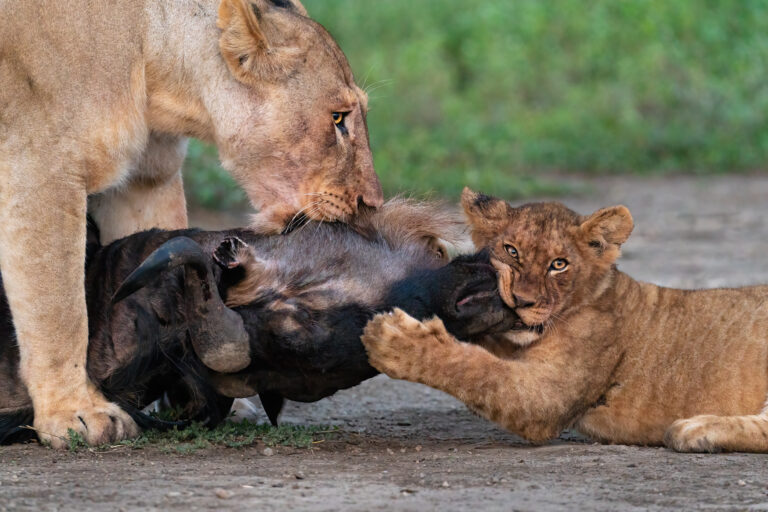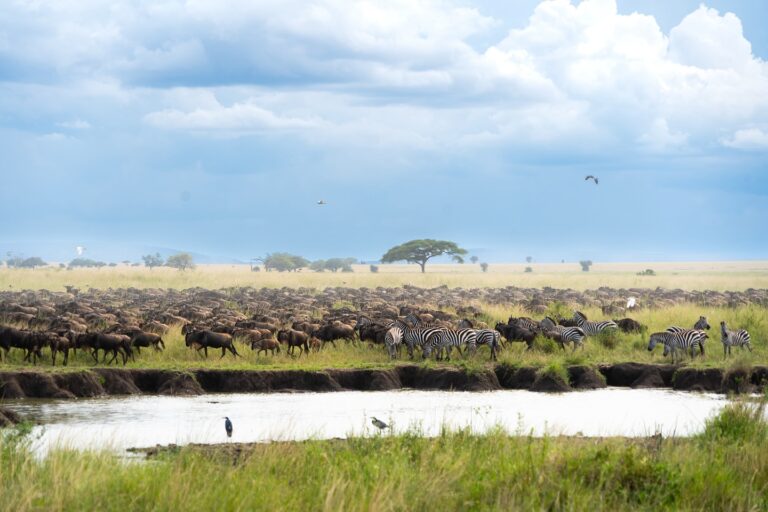What Happens During the Wildebeest Calving Season in Ndutu?
Wildebeest Calving Season in Ndutu.
The Ndutu calving season in the Serengeti National Park is one of nature’s most remarkable spectacles, drawing wildlife enthusiasts and photographers from around the world. This event occurs primarily in the Ndutu region which lies on the southern edge of the Serengeti ecosystem. The Ndutu area features lush grasslands and open savannah, providing ideal conditions for both the grazing herds and the young calves. The landscape, dotted with acacia trees and seasonal water sources, enhances the calving experience. Being on a safari to witness this unexplainable wildlife phenomenon is more than an adventure itself, come with us lets explore these magical phenomena the nature has to offer.
When does the wildebeest calving season take place?
The Ndutu calving season generally occurs from late January to mid-March. During this time, around 500,000 wildebeests give birth to their young. Approximately 8,000 baby wildebeest are born every day during calving season, coinciding with the arrival of the short rains that rejuvenate the grasslands. The peak of the calving season usually happens between late February and early March, when the majority of wildebeest calves are born. This timing also aligns with increased predator activity, as lions and other carnivores take advantage of the vulnerable newborn.
What are the unique characteristics of the wildebeest calving season in Ndutu?
-
Mass Births
The wildebeest calving season in Ndutu is marked by mass births, with thousands of calves born every day during the peak period between late January and March. Over half a million wildebeest congregate in the southern Serengeti plains, drawn by the lush, nutrient-rich grasses and abundant grazing lands. This concentrated arrival of new life is one of nature’s most extraordinary events, where it’s not uncommon to witness up to 8,000 calves being born each day. The sheer volume of newborns creates a breathtaking spectacle, as the plains become teeming with tiny, wobbly-legged wildebeest struggling to stand and take their first steps. The sight of hundreds of calves in various stages of birth and early life is a powerful testament to the resilience of the species and the survival of the fittest.
Amidst the overwhelming number of births, the intensity of life and death unfolds as predators, like lions, cheetahs, and hyenas, seize the opportunity to hunt. While many calves are born in the safety of large herds, predators know this is their time to strike. The first few hours of a calf’s life are crucial; they must be able to stand and run almost immediately in order to avoid becoming prey. This rapid development is essential for survival in a world where danger lurks at every corner. The mass births and the simultaneous predator-prey interactions make this period one of the most dramatic and captivating times to visit Ndutu, offering wildlife enthusiasts the chance to witness nature’s raw cycle of life in action.
-
Predator Interaction
During the wildebeest calving season in Ndutu, the dramatic predator-prey interactions take center stage. As thousands of vulnerable calves are born, predators such as lions, cheetahs, hyenas, and jackals are quick to capitalize on this influx of potential prey. The newborn wildebeest are especially vulnerable in their first few hours of life, when they struggle to stand and move. This makes them easy targets for predators who stalk the herds, waiting for the right moment to strike. The chase, ambush, and capture of a calf is a high-stakes game of survival for both the predators and the prey. Visitors to Ndutu during calving season are often treated to intense, heart-pounding moments as predators engage in their hunting tactics, showcasing the harsh reality of life on the Serengeti plains.
-
Geography and Environment
The Ndutu area in Southern Serengeti with abundance of nourishment these plains are perfect for wildebeest to give birth which they do in countless thousands. “The question is what makes these lush grasses of Ndutu so unique?” the answer are fertility, seasonal rainfall and availability of water sources from Lake Ndutu, on top of that the soil in Ndutu is rich in nutrients, which supports the growth of highly palatable grasses. This nutritious forage is essential for pregnant wildebeests, as it helps them build up strength and health before giving birth. Least but not last, the growth cycle of the grasses aligns perfectly with the calving season, ensuring that the wildebeests have access to high-quality forage right when they need it the most.
-
Diverse Wildlife




